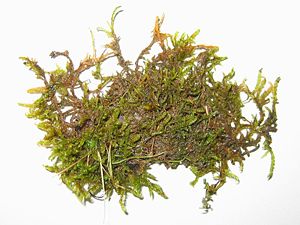Bärlapp sickle moss
| Bärlapp sickle moss | ||||||||||||
|---|---|---|---|---|---|---|---|---|---|---|---|---|

Bear moss sickle moss ( Drepanocladus lycopodioides ) |
||||||||||||
| Systematics | ||||||||||||
|
||||||||||||
| Scientific name | ||||||||||||
| Drepanocladus lycopodioides | ||||||||||||
| ( Brid. ) Warnst. |
The club moss sickle moss ( Drepanocladus lycopodioides ) is a deciduous moss that is endangered in Germany . The populations are mainly threatened by eutrophication and the destruction of its wet and boggy habitats .
features
The moderately vigorous plants of the Bärlapp sickle moss form dense, green to yellowish-brown lawns. The sparsely branched, prostrate to ascending stems are sparsely branched and can also flood in water. The central strand of the stems is reduced to a few cells. The crescent-shaped leaves are serrated in places on the edge and about 1.5 to 3 mm long. The spotted, worm-shaped prosenchymatous lamina cells are about 40 to 60 µm long and 4 to 6 µm wide. The leaf wing cells form an indistinct group of a few inflated, almost square to rectangular, often slightly tanned cells. The leaf vein, which is relatively thin at the base, usually reaches the tip of the leaf. The yellow-red, up to 4 cm long Seta bears yellow-red, elongated cylindrical capsules .
Possible confusion
The very similar Scorpidium scorpioides differs in the missing rib, the longer lamina cells and it does not develop hook-shaped curved branch tips. Drepanocladus uncinatus grows in other locations, not in bogs, but on damp wood and rock. The leaves of Drepanocladus revolvens are almost circular and have only one to three leaf wing cells. Drepanocladus sendtneri forms a strong vein and has long, pointed leaves.
Locations and distribution
Drepanocladus lycopodioides grows in limestone intermediate bogs and on meadows in partially shaded to sunny places. It often grows in large and slender sedge areas , not infrequently in water. Accompanying mosses include Calliergon trifarium , Drepanocladus revolvens or Scorpidium scorpioides . The moss, which is mainly found in Northern Europe, is relatively rare in Central and Southern Europe. In Germany it is considered critically endangered, in many federal states of Germany (including Mecklenburg-Western Pomerania) it is threatened with extinction.
literature
- Wolfgang Frey , Jan-Peter Frahm , Eberhard Fischer, Wolfram Lobin : The moss and fern plants of Europe (= small cryptogam flora. Vol. 4). Gustav Fischer, Stuttgart et al. 1995, ISBN 3-437-30756-8 .
- Martin Nebel, Georg Philippi (ed.): The mosses of Baden-Württemberg. Volume 2: Special part, (Bryophytina II, Schistostegales to Hypnobryales). Ulmer, Stuttgart 2001, ISBN 3-8001-3530-2 .

